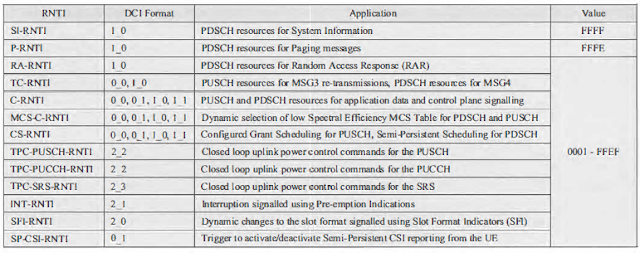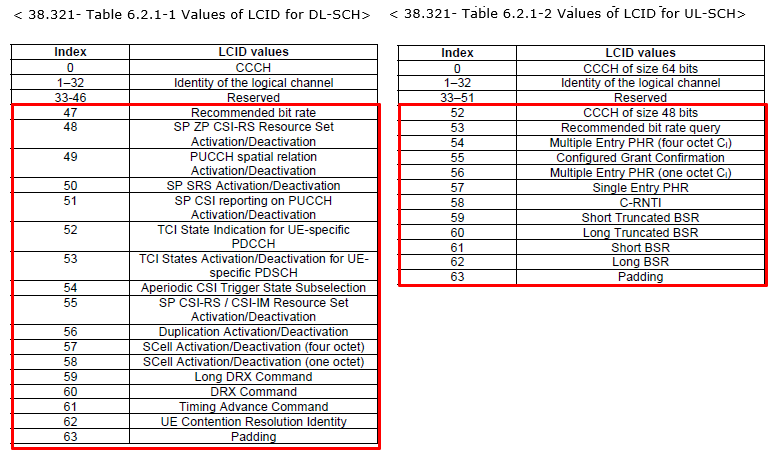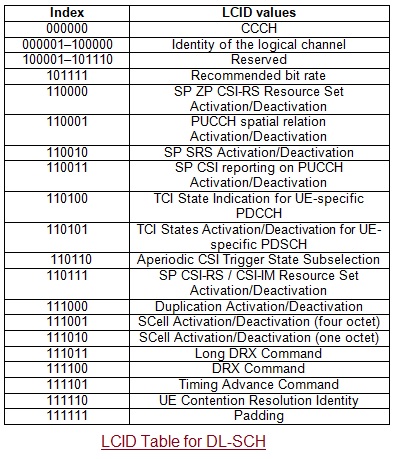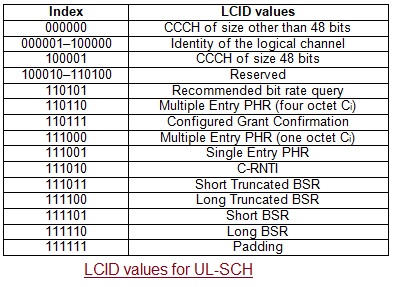In this section, I have searched all the acronyms as per the 3GPP defained. I will keep updating this list to cover most of acronyms.
| Acronym | Meaning |
| 5GC | 5G Core Network |
| 5QI | 5G QoS Identifier |
| AAS BS | Active Antenna System BS |
| ACK | Acknowledgement |
| AM | Acknowledged Mode |
| AMBR | Aggregated Maximum Bit Rate |
| AMC | Adaptive Modulation and Coding |
| AMF | Access and Mobility Management Function |
| AP | Application Protocol |
| ARP | Address Resolution Protocol |
| ARQ | Automatic Repeat request |
| AS | Access Stratum |
| ASN.1 | Abstract Syntax Notation One |
| BA | Bandwidth Adaptation |
| BCH | Broadcast Channel |
| BLER | Block Error Rate |
| BPSK | Binary Phase Shift Keying |
| BSR | Buffer Status Report |
| BWP | Bandwidth part |
| CA | Carrier Aggregation |
| CB | Code block |
| CBG | Code block group |
| CCCH | Common Control Channel |
| CCE | Control channel element |
| CE | Control Element |
| CID | Context Identifier |
| CM | Connection Management |
| CMAS | Commercial Mobile Alert Service |
| COT | Channel Occupancy Time |
| CP | Cyclic prefix |
| CP | Control Plane |
| CQI | Channel quality indicator |
| CRC | Cyclic redundancy check |
| CRI | CSI-RS Resource Indicator |
| C-RNTI | Cell RNTI |
| CS | Configured Scheduling |
| CSI | Channel state information |
| CSI-RS | Channel state information reference signal |
| CSI-RSRP | CSI reference signal received power |
| CSI-RSRQ | CSI reference signal received quality |
| CSI-SINR | CSI signal-to-noise and interference ratio |
| CS-RNTI | Configured Scheduling RNTI |
| CU | Centeral Unit |
| CW | Codeword |
| DC | Dual Connectivity |
| DCCH | Dedicated Control Channel |
| DCI | Downlink control information |
| DFT-s-OFDM | Discrete Fourier Transform-spread-Orthogonal Frequency Division Multiplexing |
| DL | Downlink |
| DL-SCH | Downlink Shared Channel |
| DM-RS | Dedicated demodulation reference signals |
| DNN | Data Network Name (Same as APN name in LTE) |
| DRB | Data Radio Bearer carrying user plane data |
| DRX | Discontinuous Reception |
| DU | Distributed Unit |
| EHPLMN | Equivalent Home Public Land Mobile Network |
| EN-DC | EUTRA-NR Dual Connectivity |
| EPC | Evolved Packet Core |
| EPRE | Energy per resource element |
| EPS | Evolved Packet System |
| ETWS | Earthquake and Tsunami Warning System |
| E-UTRA | Evolved Universal Terrestrial Radio Access |
| E-UTRAN | Evolved Universal Terrestrial Radio Access Network |
| F1AP | F1 Application Protocol |
| F1-C | F1 Control plane interface |
| F1-U | F1 User plane interface |
| FDD | Frequency Division Duplex |
| FEC | Forward Error Correction |
| FFS | For Further Study |
| FMC | First Missing Count |
| GERAN | GSM/EDGE Radio Access Network |
| GF | Grant Free |
| GFBR | Guaranteed Flow Bit Rate |
| gNB | NR Node B |
| gNB-CU | gNB Central Unit |
| gNB-DU | gNB Distributed Unit |
| GNSS | Global Navigation Satellite System |
| GSCN | Global Synchronization Raster Channel |
| GSM | Global System for Mobile Communications |
| GTP-U | GPRS Tunnelling Protocol |
| HARQ | Hybrid Automatic Repeat Request |
| HARQ-ACK | Hybrid automatic repeat request acknowledgement |
| HFN | Hyper Frame Number |
| IAB | Integrated Access/Backhaul |
| IE | Information element |
| IETF | Internet Engineering Task Force |
| IMEI | International Mobile Equipment Identity |
| IMSI | International Mobile Subscriber Identity |
| IP | Internet Protocol |
| kB | Kilobyte (1000 bytes) |
| L1 | Layer 1 |
| L2 | Layer 2 (data link layer) |
| L3 | Layer 3 (network layer) |
| LADN | Local Area Data Network |
| LCG | Logical Channel Group |
| LDPC | Low Density Parity Check |
| MAC | Medium Access Control |
| MAC-I | Message Authentication Code for Integrity |
| MCG | Master Cell Group |
| MCS | Modulation and coding scheme |
| MEC | Mobile Edge Computing |
| MFBR | Maximum Flow Bit Rate |
| MIB | Master Information Block |
| MICO | Mobile Initiated Connection Only |
| MIMO | Multiple Input Multiple Output |
| MN | Master Node |
| MR-DC | Multi-RAT Dual Connectivity |
| N/A | Not Applicable |
| NAS | Non-Access Stratum |
| NCGI | NR Cell Global Identifier |
| NCR | Neighbour Cell Relation |
| NE-DC | NR-E-UTRA Dual Connectivity |
| ng-eNB | node providing E-UTRA user plane and control plane protocol terminations towards the UE, and connected via the NG interface to the 5GC |
| NGEN-DC | NG-RAN E-UTRA-NR Dual Connectivity |
| NG-RAN | NG Radio Access Network |
| NGAP | NG Application Protocol |
| NR | NR Radio Access |
| NSA | Non StandAlone |
| NSSAI | Network Slice Selection Assistance Information |
| O&M | Operation and Maintenance |
| OFDM | Orthogonal Frequency Division Multiplexing |
| OSI | Other System Information |
| PBCH | Physical Broadcast Channel |
| PCell | Primary Cell |
| PCH | Paging Channel |
| PDCCH | Physical downlink control channel |
| PDCP | Packet Data Convergence Protocol |
| PDSCH | Physical downlink shared channel |
| PRACH | Physical Random Access Channel |
| PSS | Primary Synchronisation Signal |
| PUCCH | Physical uplink control channel |
| PUSCH | Physical uplink shared channel |
| PDU | Protocol Data Unit |
| PHR | Power Headroom Report |
| PLMN | Public Land Mobile Network |
| PMI | Precoding Matrix Indicator |
| PRACH | Physical random access channel |
| PRB | Physical resource block |
| PRG | Physical resource block group |
| PSS | Primary synchronization signal |
| PTAG | Primary Timing Advance Group |
| PTI | Procedure Transaction Identity |
| PT-RS | Phase-tracking reference signal |
| PUCCH | Physical uplink control channel |
| PUSCH | Physical uplink shared channel |
| PWS | Public Warning System |
| QAM | Quadrature Amplitude Modulation |
| QCL | Quasi-collocation |
| QFI | QoS Flow ID |
| QoS | Quality of Service |
| QPSK | Quadrature Phase Shift Keying |
| RACH | Random Access Channel |
| RAN | Radio Access Network |
| RAT | Radio Access Technology |
| RB | Resource block |
| RB | Radio Bearer |
| RBG | Resource block group |
| RE | Resource element |
| REG | Resource element group |
| RF | Radio Frequency |
| RI | Rank indication |
| RIV | Resource indicator value |
| RLC | Radio Link Control |
| RMSI | Remaining Minimum SI(System Information) |
| RNA | RAN-based Notification Area |
| RNAU | RAN-based Notification Area Update |
| RNL | Radio Network Layer |
| RNTI | Radio Network Temporary Identifier |
| ROHC | RObust Header Compression |
| RPLMN | Registered Public Land Mobile Network |
| RQA | Reflective QoS Attribute |
| RQoS | Reflective Quality of Service |
| RRC | Radio Resource Control |
| RS | Reference signal |
| RSRP | Reference signal received power |
| RTP | Real Time Protocol |
| SA | StandAlone |
| SAP | Service Access Point |
| SCell | Secondary Cell |
| SCG | Secondary cell group |
| SCH | Shared Channel |
| SCTP | Stream Control Transmission Protocol |
| SDAP | Service Data Adaptation Protocol |
| SDF | Service Data Flow |
| SDU | Service Data Unit |
| SFN | System Frame Number |
| SI | System Information |
| SIB | System Information Block |
| SM | Session Management |
| SMF | Session Management Function |
| SMTC | SS block based RRM measurement timing configuration |
| SN | Sequence Number |
| SN | Secondary Node |
| SNN | Serving Network Name |
| S-NSSAI | Single NSSAI |
| SpCell | Special Cell |
| SPS | Semi-Persistent Scheduling |
| SR | Scheduling request |
| SRB | Signalling Radio Bearer |
| SRB | Signalling Radio Bearer carrying control plane data |
| SRS | Sounding reference signal |
| SS | Synchronisation signal |
| SSB | Synchronization Signal Block |
| SSC | Session and Service Continuity |
| SS-RSRP | SS reference signal received power |
| SS-RSRQ | SS reference signal received quality |
| SSS | Secondary synchronization signal |
| SS-SINR | SS signal-to-noise and interference ratio |
| STAG | Secondary Timing Advance Group |
| S-TMSI | SAE Temporary Mobile Station Identifier |
| SUL | Supplementary Uplink |
| TA | Timing advance |
| TAG | Timing advance group |
| TB | Transport Block |
| TCI | Transmission Configuration Indicator |
| TCP | Transmission Control Protocol |
| TPC | Transmit Power Control |
| TDD | Time Division Duplex |
| TDM | Time division multiplexing |
| TM | Transparent Mode |
| TNL | Transport Network Layer |
| TRP | Transmission and Reception Point |
| TPC-CS-RNTI | Transmit Power Control-Configured Scheduling-RNTI |
| TPC-PUCCH-RNTI | Transmit Power Control-Physical Uplink Control Channel-RNTI |
| TPC-PUSCH-RNTI | Transmit Power Control-Physical Uplink Shared Channel-RNTI |
| TPC-SRS-RNTI | Transmit Power Control-Sounding Reference Symbols-RNTI |
| TTI | Transmission Time Interval |
| UCI | Uplink control information |
| UDP | User Datagram Protocol |
| UE | User equipment |
| UICC | Universal Integrated Circuit Card |
| UL | Uplink |
| UL-SCH | Uplink shared channel |
| UM | Unacknowledged Mode |
| UP | User Plane |
| UPF | User Plane Function |
| URLLC | Ultra-Reliable and Low Latency Communications |
| URN | Uniform Resource Name |
| UTC | Coordinated Universal Time |
| UTRAN | Universal Terrestrial Radio Access Network |
| X-MAC | Computed MAC-I |
| Xn | network interface between NG-RAN nodes |
| Xn-C | Xn-Control plane (control plane interface between NG-RAN and 5GC) |
| Xn-U | Xn-User plane (user plane interface between NG-RAN and 5GC) |
| XnAP | Xn Application Protocol |




















